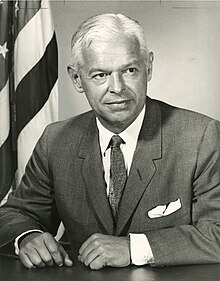
Back بول نيتز Arabic بول نيتز ARZ Paul Nitze Catalan Paul Nitze German Paul Nitze Spanish Paul Nitze French Paul Nitze Irish פול ניצה HE Paul Henry Nitze Italian ポール・ニッツェ Japanese
Paul Nitze | |
|---|---|
 | |
| 12th United States Deputy Secretary of Defense | |
| In office July 1, 1967 – January 20, 1969 | |
| President | Lyndon B. Johnson |
| Preceded by | Cyrus Vance |
| Succeeded by | David Packard |
| 58th United States Secretary of the Navy | |
| In office November 29, 1963 – June 30, 1967 | |
| President | Lyndon B. Johnson |
| Preceded by | Fred Korth |
| Succeeded by | Paul Ignatius |
| Assistant Secretary of Defense for International Security Affairs | |
| In office January 29, 1961 – November 29, 1963 | |
| President | John F. Kennedy Lyndon B. Johnson |
| Preceded by | John N. Irwin II |
| Succeeded by | William Bundy |
| 2nd Director of Policy Planning | |
| In office January 1, 1950[1] – May 28, 1953 | |
| President | Harry S. Truman Dwight D. Eisenhower |
| Preceded by | George F. Kennan |
| Succeeded by | Robert R. Bowie |
| Personal details | |
| Born | Paul Henry Nitze January 16, 1907 Amherst, Massachusetts, U.S. |
| Died | October 19, 2004 (aged 97) Washington, D.C., U.S. |
| Spouses | Phyllis Pratt
(m. 1932; died 1987)Elisabeth Scott Porter
(m. 1993) |
| Children | 4 |
| Education | Harvard University (BA) |
Paul Henry Nitze (January 16, 1907 – October 19, 2004) was an American businessman and government official who served as United States Deputy Secretary of Defense, U.S. Secretary of the Navy, and Director of Policy Planning for the U.S. State Department. He is best known for being the principal author of NSC 68 and the co-founder of Team B. He helped shape U.S. Cold War defense policy over the course of numerous presidential administrations.[2]
- ^ "Directors of the Policy Planning Staff".
- ^ Strobe Talbott, The Master of the Game: Paul Nitze and the Nuclear Peace (1989).